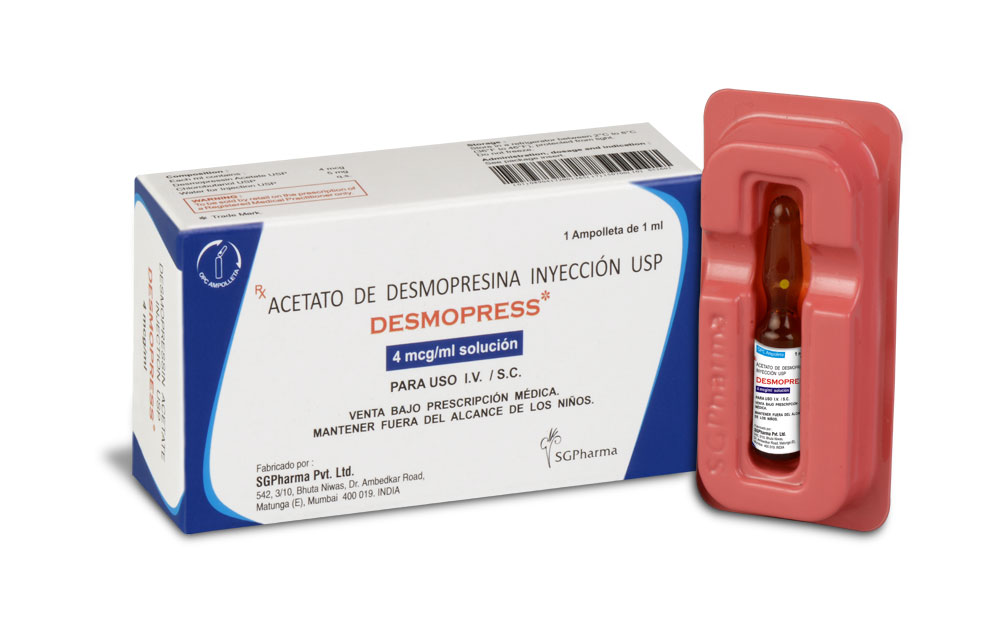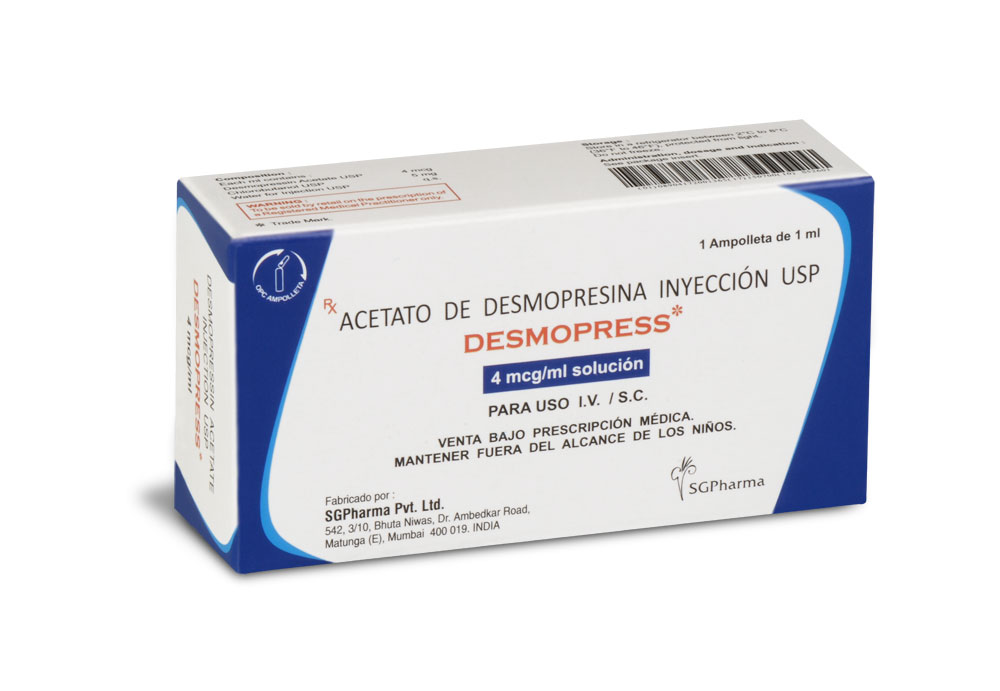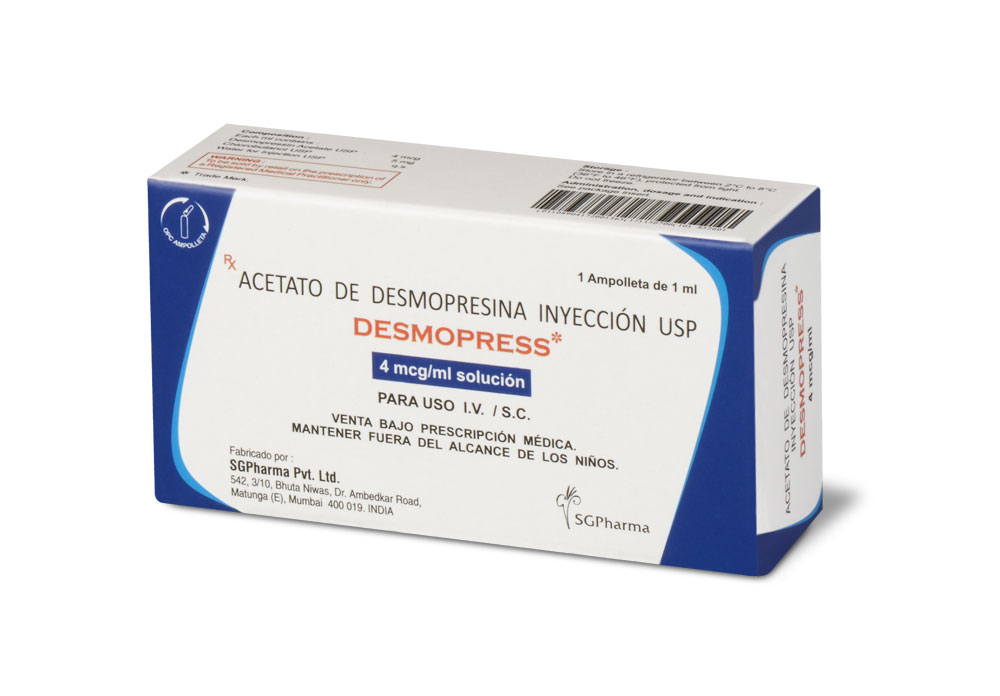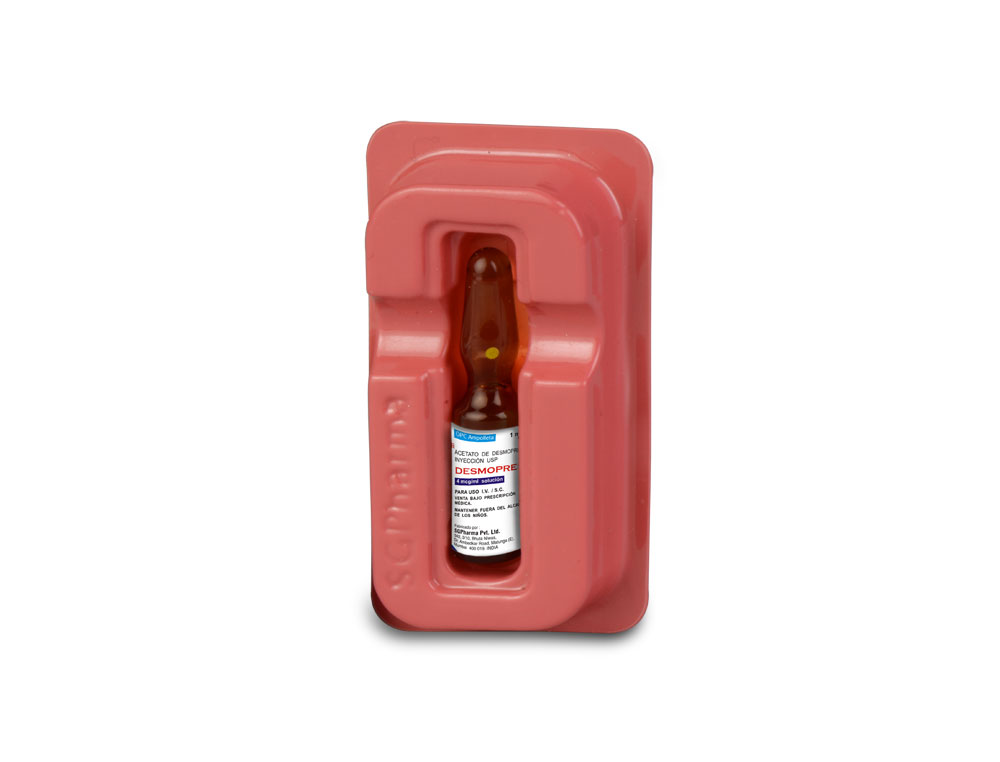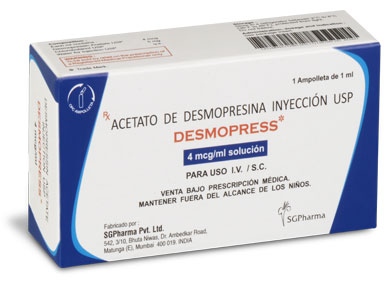
4 mcg/ml
For the use of a Registered Medical Practitioner or a Hospital or a Institution only.
DESMOPRESS (Desmopressin Acetate) is a synthetic octapeptide hormone having the property of antidiuresis. It is a synthetic analog of vasopressin. Chemically, Desmopressin Acetate is 1-(3-mercaptopropionic acid)-8-d-arginine-vasopressin monoacetate (salt) trihydrate. The molecular formula is C46H64N14O12S2•C2H402•3H2O and molecular weight is 1183.31.
STRUCTURAL FORMULA :
Its structural formula is :
-Structure.jpg)
DESMOPRESS is a sterile, clear, colourless, aqueous solution filled in amber ampoule of suitable size.
COMPOSITION :
Each ml contains :
Desmopressin Acetate USP 4 mcg
Chlorobutanol USP 5 mg
(as preservative)
Water for Injection USP q.s.
ACTIONS :
Desmopressin Acetate has antidiuretic effect that decreases urinary volume and increases urine osmolality. Desmopressin Acetate a synthetic analogue of the natural hormone arginine vasopressin. One ml (4 µg) of Desmopressin Acetate solution has an antidiuretic activity of about 16 IU; 1 µg of desmopressin acetate is equivalent to 4 IU. Desmopressin Acetate has been shown to be more potent than arginine vasopressin in increasing plasma levels of factor VIII activity in patients with haemophilia and von Willebrand’s disease Type I.
PHARMACOKINETICS :
Dose-response studies were performed in healthy persons, using doses of 0.1 to 0.4 mcg/kg body weight, infused over a 10-minute period. Maximal dose response occurred at 0.3 to 0.4 mcg/kg. The response to desmopressin acetate of factor VIII activity and plasminogen activator is dose-related, with maximal plasma levels of 300 to 400 percent of initial concentrations obtained after infusion of 1 mcg/kg body weight. The increase is rapid and evident within 30 minutes, reaching a maximum at a point ranging from 90 minutes to two hours. The factor VIII related antigen and ristocetin cofactor activity were also increased to a smaller degree, but still are dose-dependent.
1. The biphasic half-lives of desmopressin were 7.8 and 75.5 minutes for the fast and slow phases, respectively, compared with 2.5 and 14.5 minutes for lysine vasopressin, another form of the hormone. As a result, desmopressin acetate provides a prompt onset of antidiuretic action with a long duration after each administration.
2. The change in structure of arginine vasopressin to desmopressin acetate has resulted in a decreased vasopressor action and decreased actions on visceral smooth muscle relative to the enhanced antidiuretic activity, so that clinically effective antidiuretic doses are usually below threshold levels for effects on vascular or visceral smooth muscle.
3. When administered by injection, desmopressin acetate has an antidiuretic effect about ten times that of an equivalent dose administered intranasally.
4. The bioavailability of the subcutaneous route of administration was determined qualitatively using urine output data. The exact fraction of drug absorbed by that route of administration has not been quantitatively determined.
5. The percentage increase of factor VIII levels in patients with mild haemophilia A and von Willebrand’s disease was not significantly different from that observed in normal, healthy individuals when treated with 0.3 mcg/kg of desmopressin acetate infused over ten minutes.
6. Plasminogen activator activity increases rapidly after desmopressin acetate infusion, but there has been no clinically significant fibrinolysis in patients treated with desmopressin acetate.
7. The effect of repeated desmopressin acetate administration
when doses were given every 12 to 24 hours has generally shown a gradual diminution of the factor VIII activity increase noted with a single dose. The initial response is reproducible in any particular patient if there are 2 or 3 days between administrations. Desmopressin Acetate is mainly excreted in the urine. A pharmacokinetic study conducted in healthy volunteers and patients with mild, moderate, and severe renal impairment (n=24,6 subjects in each group) receiving single dose desmopressin acetate (2 mcg) injection demonstrated a difference in desmopressin acetate injection terminal half-life. Terminal half-life significantly increased from 3 hours in normal healthy patients to 9 hours in patients with severe renal impairment.
INDICATIONS :
Haemophilia A
DESMOPRESS is indicated for patients with haemophilia A with factor VIII coagulant activity levels greater than 5 %.
DESMOPRESS will often maintain haemostasis in patients with haemophilia A during surgical procedures and postoperatively when administered 30 minutes prior to scheduled procedure.
DESMOPRESS will also stop bleeding in haemophilia A patients with episodes of spontaneous or trauma-induced injuries such as haemarthroses, intramuscular haematomas or mucosal bleeding.
Von Willebrand’s Disease (Type I) :
DESMOPRESS is indicated for patients with mild to moderate classic von Willebrand’s disease (Type I) with factor VIII levels greater than 5 %. Desmopressin acetate will often maintain haemostasis in patients with mild to moderate von Willebrand’s disease during
surgical procedures and postoperatively when administered 30 minutes prior to the scheduled procedure. DESMOPRESS will usually stop bleeding in mild to moderate von Willebrand’s patients with episodes of spontaneous or trauma-induced injuries such as haemarthroses, intramuscular haematomas or mucosal bleeding. Those von Willebrand’s disease patients who are least likely to respond are those with severe homozygous von Willebrand’s disease with factor VIII coagulant activity and factor VIII von Willebrand factor antigen levels less than 1 %. Other patients may respond in a variable fashion depending on the type of molecular defect they have. Bleeding time and factor VIII coagulant activity, ristocetin cofactor activity, and von Willebrand factor antigen should be checked during administration of DESMOPRESS to ensure that adequate levels are being achieved. DESMOPRESS is not indicated for the treatment of severe classic von Willebrand’s disease (Type I) and when there is evidence of an abnormal molecular form of factor VIII antigen.
Diabetes Insipidus :
DESMOPRESS is indicated as antidiuretic replacement therapy in the management of central (cranial) diabetes insipidus and for the management of the temporary polyuria and polydipsia following head trauma or surgery in the pituitary region. Desmopressin acetate is ineffective for the treatment of nephrogenic diabetes insipidus. Desmopressin acetate is also available as an intranasal preparation. However, this means of delivery can be compromised by a variety of factors that can make nasal insufflation ineffective or inappropriate. These include poor intranasal absorption, nasal congestion and blockage, nasal discharge, atrophy of nasal mucosa, and severe atrophic rhinitis. Intranasal delivery may be inappropriate where there is an impaired level of consciousness. In addition, cranial surgical procedures, such as transphenoidal hypophysectomy, create situations where an alternative route of administration is needed as in cases of nasal packing or recovery from surgery.
Administration :
For intravenous and subcutaneous use.
INSTRUCTIONS FOR USE OF AMPOULE :
The ampoule used in this product is equipped with O.P.C (One Point Cut) opening system. No ampoule file is needed to open the ampoule. The neck of the ampoule is prescored at the point of constriction. A coloured dot on the ampoule head helps to orientate the ampoule. Take the ampoule and face the coloured dot. Let the solution at the head of the ampoule to flow down by shaking or a gentle stroke. The ampoule opens easily by placing the thumb on the coloured dot and gently pressing downwards as shown.

Dosage :
Haemophilia A and von Willebrand’s Disease (Type I)
DESMOPRESS is administered as an intravenous infusion at a dose of 0.3 mcg desmopressin acetate/kg body weight diluted in sterile physiological saline and infused slowly over 15 to 30 minutes. In adults and children weighing more than 10 kg, 50 ml of diluent is
recommended; in children weighing 10 kg or less, 10 ml of diluent is recommended. Blood pressure and pulse should be monitored during infusion. If DESMOPRESS is used preoperatively, it should be administered 30 minutes prior to the scheduled procedure. The necessity for repeat administration of DESMOPRESS or use of any blood products for haemostasis should be determined by laboratory response as well as the clinical condition of the patient. The tendency toward tachyphylaxis (lessening of response) with repeated administration given more frequently than every 48 hours should be considered in treating each patient. Fluid restriction should be observed.
Diabetes Insipidus :
This formulation is administered subcutaneously or by direct intravenous injection. DESMOPRESS dosage must be determined for each patient and adjusted according to the pattern of response. Response should be estimated by two parameters : adequate duration of
sleep and adequate, not excessive, water turnover. The usual dosage range in adults is 0.5 ml (2 mcg) to 1 ml (4 mcg) daily, administered intravenously or subcutaneously, usually in two divided doses. The morning and evening doses should be separately adjusted for an adequate diurnal rhythm of water turnover. For patients who have been controlled on intranasal desmopressin acetate and who must be switched to the injection form, either because of poor intranasal absorption or because of the need for surgery, the comparable antidiuretic dose of the injection is about one-tenth the intranasal dose. Fluid restriction should be observed.
Geriatric Use
This drug is known to be substantially excreted by the kidney, and the risk of toxic reactions to this drug may be greater in patients with impaired renal function. Because elderly patients are more likely to have decreased renal function, care should be taken in dose
selection, and it may be useful to monitor renal function.
Pregnancy : Category B
Fertility studies have not been done. Teratology studies in rats and rabbits at doses from 0.05 to 10 mcg/kg/day (approximately 0.1 times the maximum systemic human exposure in rats and up to 38 times the maximum systemic human exposure in rabbits based on surface area mg/m2) revealed no harm to the foetus due to desmopressin acetate. There are, however, no adequate and well controlled studies in pregnant women. Because animal reproduction studies are not always predictive of human response, this drug should be used during pregnancy only if clearly needed. Several publications of desmopressin acetate’s use in the management of diabetes insipidus during pregnancy are available ; these include a few anecdotal reports of congenital anomalies and low birth weight babies. However, no causal connection between these events and desmopressin acetate has been established. A fifteen year, Swedish epidemiologic study of the use of desmopressin acetate in pregnant women with diabetes insipidus found the rate of birth defects to be no greater than that in the general population; however, the statistical power of this study is low. As opposed to preparations containing natural hormones, desmopressin acetate in antidiuretic doses has no uterotonic action and the physician will have to weigh the therapeutic advantages against the possible risks in each case.
Nursing mothers :
There have been no controlled studies in nursing mothers. A single study in postpartum women demonstrated a marked change in plasma, but little if any change in assayable desmopressin in breast milk following an intranasal dose of 10 mcg. It is not known whether this drug is excreted in human milk. Because many drugs are excreted in human milk, caution should be exercised when DESMOPRESS is administered to a nursing woman.
Paediatric Use :
Use in infants and paediatric patients will require careful fluid intake restriction to prevent possible hyponatremia and water intoxication. Fluid restriction should be discussed with the patient and/or guardian. DESMOPRESS should not be used in infants less than three months of age in the treatment of haemophilia A or von Willebrand’s disease; safety and effectiveness in paediatric patients under 12 years of age with diabetes insipidus have not been established.
INTERACTIONS AND INCOMPATIBILITIES :
Although the pressor activity of desmopressin acetate is very low compared with the antidiuretic activity, use of doses as large as 0.3 mcg/kg of desmopressin acetate with other pressor agents should be done only with careful patient monitoring. The concomitant administration of drugs that may increase the risk of water intoxication with hyponatremia, (e.g. tricyclic antidepressants, selective serotonin re-uptake inhibitors, chlorpromazine, opiate analgesics, NSAIDs, lamotrigine and carbamazepine) should be performed with caution. DESMOPRESS has been used with epsilon aminocaproic acid without adverse effects. There have been rare reports of thrombotic events (acute cerebrovascular thrombosis, acute myocardial infarction) following DESMOPRESS in patients predisposed to thrombus formation, and rare reports of hyponatremic convulsions associated with concomitant use with the following medications : oxybutinin and imipramine. Carcinogenesis, Mutagenesis, Impairment of Fertility Studies with desmopressin acetate have not been performed to evaluate carcinogenic potential, mutagenic potential or effects on fertility.
SIDE EFFECTS :
Infrequently, desmopressin acetate has produced transient headache, nausea, mild abdominal cramps and vulval pain. These symptoms disappeared with reduction in dosage. Occasionally, DESMOPRESS has produced local erythema, swelling, or burning pain. Occasional facial flushing has been reported with the administration of desmopressin acetate. DESMOPRESS has infrequently produced changes in blood pressure causing either a slight elevation or a transient fall and a compensatory increase in heart rate. Severe allergic reactions including anaphylaxis have been reported rarely with DESMOPRESS.
OVERDOSAGE :
Signs of overdose may include confusion, drowsiness, continuing headache, problems with passing urine and rapid weight gain due to fluid retention.
TREATMENT OF OVERDOSAGE :
In case of overdosage, the dosage should be reduced, frequency of administration decreased, or the drug withdrawn according to the severity of the condition. There is no known specific antidote for DESMOPRESS. An oral LD50 has not been established. An intravenous dose of 2 mg/kg in mice demonstrated no effect.
PHARMACEUTICAL PRECAUTIONS :
Parenteral drug products should be inspected visually for particulate matter and discoloration prior to administration, whenever solution and container permit.
STORAGE :
Store in a refrigerator between 2°C to 8°C (36°F to 46°F), protected from light.
Do not freeze.
SHELF LIFE :
24 months from the date of manufacture.
PRESENTATION :
DESMOPRESS is supplied as Desmopressin Acetate USP 4 mcg in 1 ml aqueous solution.
Such 1 ampoule of 1 ml is packed in a box.
Disclaimer : For the use of a Registered Medical Practitioner or a Hospital or a Institution only. Also it is not intended to be used by healthcare professionals or patients for the purpose of prescribing or administering these products. Questions regarding the complete and current content of product labeling / specification / presentation should be directed to SGPharma.

 Cardiovascular
Cardiovascular



